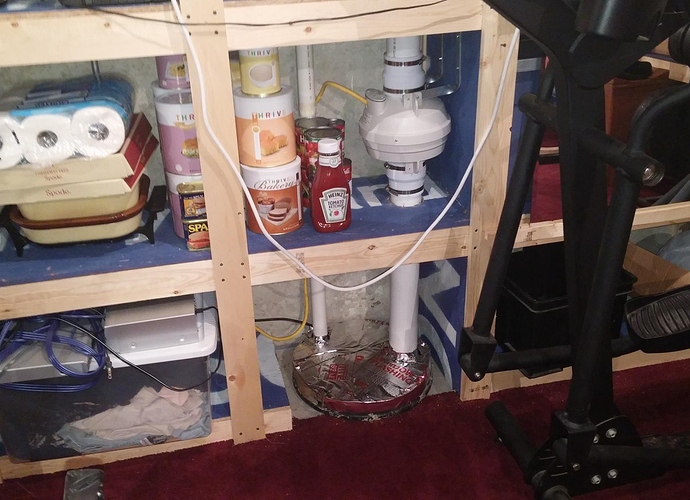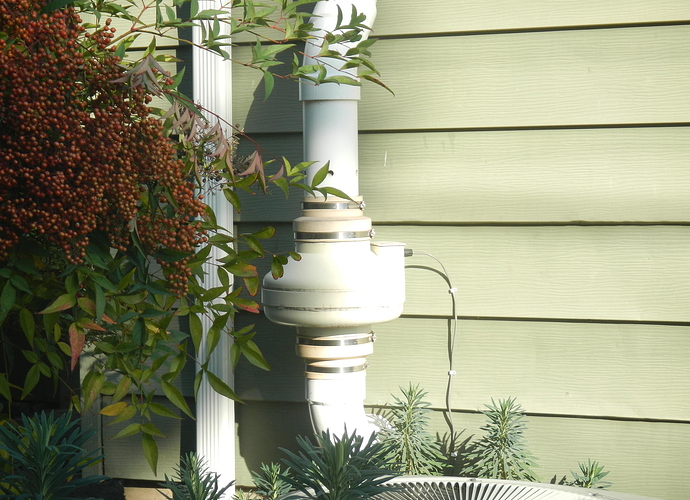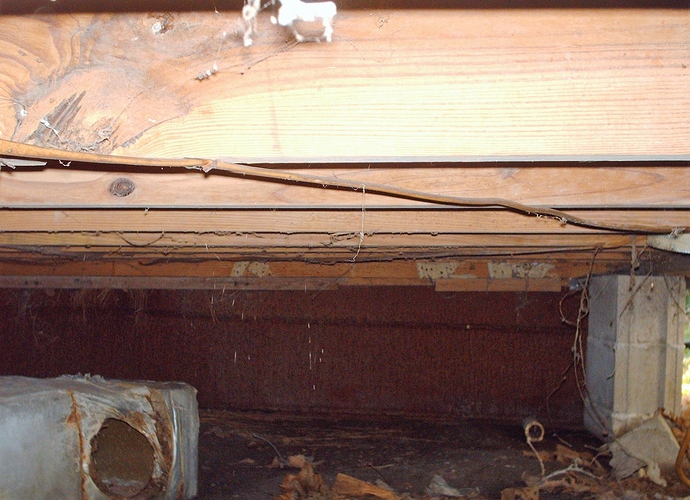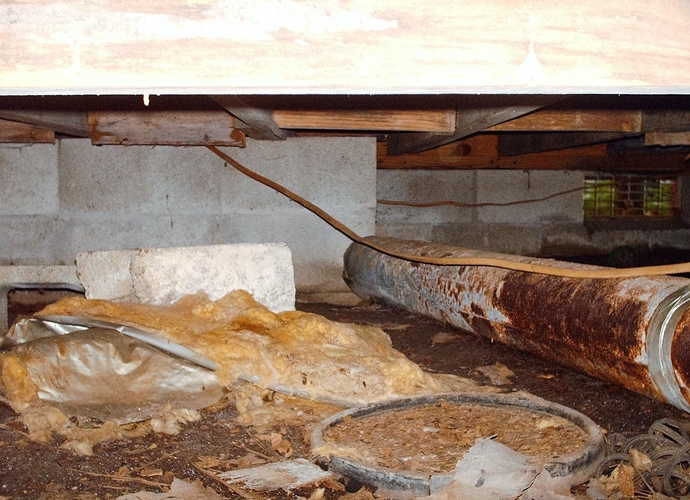I went to a radon inspection last week and the radon was high. I did not take any pictures and don’t have access to another radon system currently. It’s amazing that no one I know has ever heard of Radon and yet it’s such a big problem.
This is an example of a typical rough in for a under slab vent system. If testing indicated a need for mitigation this pipe could be converted to either a passive or active under slab ventaltion system. In addition the sump just to the left would need to be sealed so that the vent would be effective.
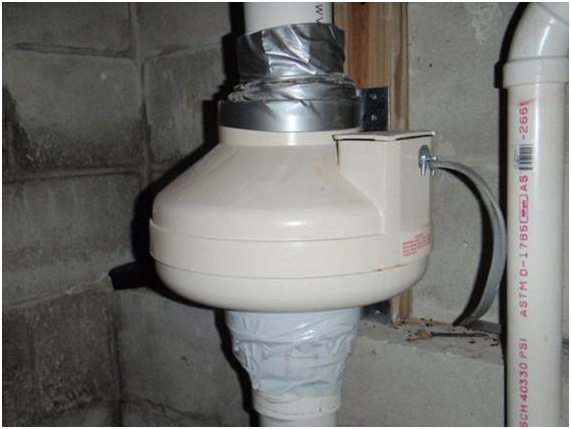
Course fulfillment essay.
Visual inspection of radon mitigation system revealed damaged connections at the inlet and outlet of the inline radon fan, located in the basement. This is a safety hazard and a condition conducive to improper flow and leakage of radioactive contaminates. System should be evaluated and repaired by a radon mitigation specialist.
Radon course requirement:
This radon mitigation system was externally mounted. A manometer was noted in the basement. The unit was properly installed, the sump pit was properly sealed and vented above the exterior eave.
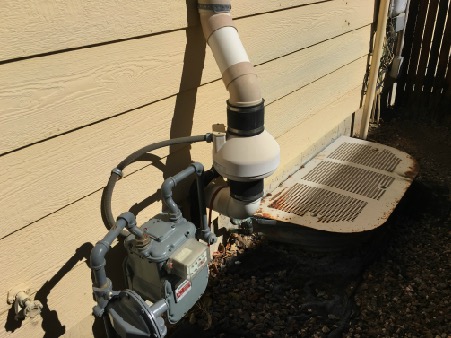
This is an inspection of a radon mitigation system. This home was tested for radon, The average was 12.6 pCi/l . This was high and the homeowner installed a radon mitigation system. Radon was tested again and the average was 1.9 pCi/l This is an acceptable and safe level. However the radon mitigation fan is inside the basement. Recommend to move the fan to the outside of the home.
Ed
The picture posted is of a broken vent pipe for a dryer. This is a serious fire hazard not to mention the fact that hot air and lint will be dumping into the house. This is an automatic repair replace on all My reports!
Radon occurs during the decay of Uranium underground. Radon gas is the second leading cause of lung cancer next to smoking. If You smoke and have high Radon in Your house the chances increase greatly for lung cancer. Radon is measured in Picocuries named after Madame Curie. Anything reading over 4.0 pCi/L litre is high. The average house has 1.3pCi/L
This crack extends below grade. This is a possible location for radon gas to enter the home. Recommendations include review by a licensed structural engineer and to seal this crack along with many other present in the foundation to prevent radon gas entry into the home.
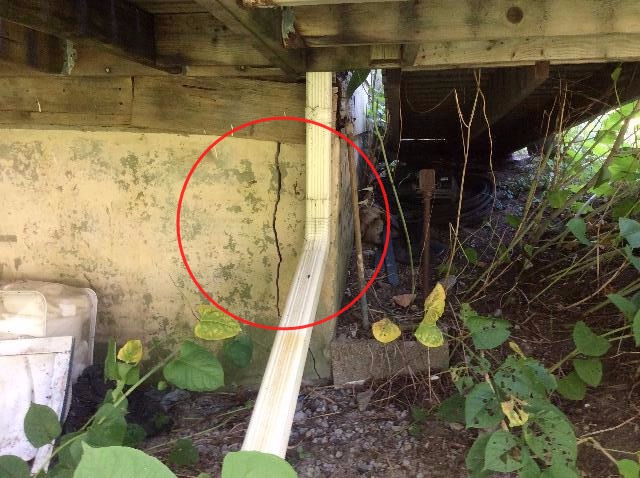
Article: A garage inspection
Trusses can not be altered in any way without a structural engineer`s approval. If you come across plywood triangular gussets at truss intersections, recommend evaluation by a structural engineer. Start at the top and have your eyes follow the home how loads will be transferred.
I inspected this home on 10/12/15. The radon sub slab depressurization mitigation system was installed in 2013. The fan is located outdoors with its own dedicated outlet. The pressure is acceptable. In my report I recommended the home be re-measured per EPA recommendation all homes be measured every 2 years.
Sealed sump pump.
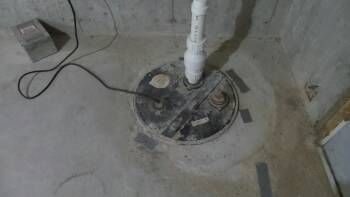
This sump pump has a cover that is bolted on to the sump bucket.
This does not meet the standards for a properly sealed sump pump/ pit for the purposes of radon mitigation for the home.
The sump pit should have a continuous caulked seal between the bucket and cover.
Chris Sullivan
Peak Performance Home and Building Inspections

During a home inspection I discovered the radon mitigation liquid sight gauge level to be even which indicated to me that the system may not be functioning, I went outside and found the fan turned off, getting permission from the listing/buyer agent I turned on the fan and found it to not be functioning the outlet was tested and found to be functional.
I may be a day older but never too old to learn.
Taking a deep breath and diving in.
This home is equipped with a functioning radon mitigation system. Radon system operation can be verified by a water manometer located in the crawl space. A difference of about 1" in the water level from one side to the other in the manometer indicates that the fan (located outside the home) is operating and creating a slight vacuum to draw radon gasses out of the home. A light touch anywhere along the length of PVC pipe comprising this system will exhibit a slight vibration which also indicates an operating fan.
A notation on the system pipe indicates that a new fan was installed on May 27, of this year.
Fan in basement sub-slab radon mitigation system appears to be operating continuously, as intended. No apparent breaks in discharge pipe, continuous to above roof line. Pipe sealed at basement slab; no significant deterioration apparent. Pressure sensing alarm device appears to be intact. Recommend test for radon in lowest occupied level of home to verify system functioning properly. Currently, seller has entertainment room in basement, so that is the level that should be tested.
Re: Radon Gas (consumer-targeted)
Good resource for potential customers, although graphics (home buyer’s and seller’s guide, radon risk bar chart, etc.) did not display in Google Chrome. I question the recommendation (5.a.) that if clients hire a home inspector to test for radon, he/she should be an IAC2-certified air quality inspector. IMO, it’s enough that the home inspector be certified by his/her state, or the National Radon Proficiency Program, as a radon measurement provider.
Re: Vapor Barriers
Good discussion, and graphics were viewable in Google Chrome. A little more information might be helpful, such as recommended thickness for different applications (e.g. 6 mil for crawl spaces) and crawl space seam overlap recommendations. I see lots of crawl spaces where the vapor barrier is in all sorts of states of disrepair and improper installation!
This picture of a crawlspace with a lot of debris in it, which needs to be removed. The crawlspace has an uncovered dirt floor. The dirt floor needs to be covered with a minimum 6 mil. plastic covering, of the entire area of the crawlspace. Overlaps should be at least 12”, and sealed. The plastic sheeting should go up the walls a min. of 12”, and sealed.
InterNACHI Home Inspection Report Checklist
Client name: Sarah A. Wallack
Inspected property address: 607 Kennel Lane, Jacksonville, NC 28540
Date and time of the inspection: 10/22/2015 @ 1:35PM
Weather conditions: Clear and sunny
Approximate outdoor air temperature: 70 F
People present at the time of the inspection: Client
Estimated year built: 1972
Type of structure inspected: Single Family Home
Company name: Old North State Inspection Services
Inspector name: Howard McAdam
Company phone: (910) 545-7245
Company email: onsisc@yahoo.com
Company address: 607 B Kennel Lane, Jacksonville, NC 28540
InterNACHI Home Inspection Report Checklist
BASEMENT, FOUNDATION, CRAWLSPACE & STRUCTRUE
Inspected: IN Not Inspected: NI Not Present: NP Not in the Scope of the Inspection: NS
INSPECT:
I inspected the foundation: NP
I inspected the basement: NP
I inspected the crawlspace: IN
I inspected the structural components: IN
DESCRIBE:
The type of foundation can be described as:
basement
crawlspace X
slab–‐on–‐grade
concrete block
poured concrete
other
The location of the access to the under–‐floor space is:
NW corner of the home near the service entrance mast.
REPORT:
I saw evidence of clutter in the crawlspace, Correction is needed. Recommend cleaning the debris from the crawlspace to reduce the
likelihood of critters nesting in it under your home.
Saw evidence of no plastic covering on the dirt floor of the crawlspace. There should be a soil covering to reduce the soil gasses, such as Radon. (Radon is an odorless, tasteless gas radioactive gas, that is the 2nd leading cause of lung cancer just under smoking.)
Recommend that you consult a Radon Tester to determine if there is an elevated level of Radon in the soil under your home. The EPA recommends that Radon level of 4pCi/l, or more, (4 picocurie per liter of air. Picocurie is a measurement of radioactivity) should be mitigated. The Radon Tester can take an air sample and send it to a laboratory for analyses.
If the laboratory results show that elevated levels of Radon in your home, my recommendation is to consult a NC Licensed Radon Mitigation Contractor to design a Radon Mitigation System to lower the Radon level of your home. The soil should be covered with a plastic covering and the Radon Mitigation System can be placed under the plastic covering. An added benefit to the plastic covering is to control moisture intrusion.
The 1st article I read was Radon. Radon is an odorless, tasteless radioactive gas, a byproduct of uranium that is present in soil and rocks all over the United States. The Surgeon General of the United States has warned that Radon is the 2nd leading cause of lung cancer. Testing your home is the only way to know the level of Radon is possibly in your home. Radon has been found in homes in all the states in the United States. One in every 15 homes have Radon levels of 4pCi/L or more. If the home has elevated levels of Radon, 4pCi/l or more, the home should be mitigated. A Radon Mitigation Contractor should be consulted to determine the best way to lower the Radon levels of the home. The 2nd article I read was Backdrafting. Backdrafting is the reverse flow of gases in the flues of fuel-fired appliances that result in the intrusion of combustion gases, such as carbon monoxide, into the living space. As homes are being sealed tighter, that increases the possibility of backdrafting. Care has to be taken to make sure the different systems of the home work in harmony with all the other systems.
Course Articles:
Radon
Radon is a radioactive gas that has been shown to cause lung cancer. You cannot taste it, see it or smell it but it could be accumulating to dangerous levels in your home. Whether buying or selling a home you should have a test performed to detect these levels. Any levels of 4 pCi/L or more should be considered high enough to warrant mitigation practices. There are many mitigation systems that can be utilized for Radon removal and the costs can vary between $500 and $2500 to complete.
Cause of Deaths in the U.S.
This article puts in perspective the various causes of death in the U.S. In regards to lung cancer from Radon, there are approximatley 21,000 cases per year. This number is substantial and since testing is relatively inexpensive it is something I think all homeowners should have done regularly.

